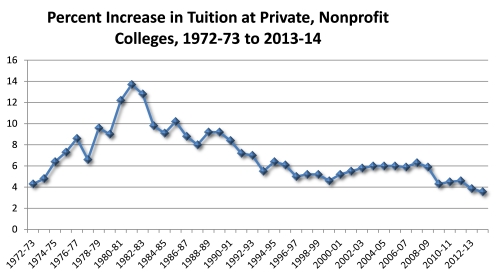Published Tuition at Private Institutions Grew an Average of 3.6 Percent for 2013-14;
Institutional Student Aid up 6.9 Percent
WASHINGTON, D.C. (October 10, 2013) — Students and families entering the nation’s private, nonprofit colleges and universities this academic year experienced the lowest tuition and fee rate increases in at least four decades. According to an annual survey of its members, the National Association of Independent Colleges and Universities (NAICU) reports published tuition and fees increased by just 3.6 percent for the 2013-2014 academic year. At the same time, institutional student aid budgets at private colleges increased an average of 6.9 percent for 2013-14.
This is the fifth consecutive year that the percentage increase in published tuition has stayed below pre-recession rates, and the second time in at least four decades it has been below 4 percent. From 2009-10 to 2013-14, average private college tuition increases ran in the mid-four percent range, down from an average annual increase of nearly 6 percent during the previous 10 years. This year’s rate is the lowest NAICU has on record dating back to 1972-73 (see chart below).
“During the past five years, private colleges and universities across the nation have redoubled efforts and implemented innovative initiatives to cut their operating costs, improve their efficiency, and enhance their affordability,” said NAICU President David L. Warren. “This, coupled with generous institutional student aid policies, has resulted in a private higher education that is accessible and affordable to students and families from all backgrounds.”
According to NAICU, data show that the average inflation-adjusted net tuition and fees (published tuition and fees minus grant aid from all sources and federal higher education tax benefits) has increased just $230, to $13,380, at private, nonprofit institutions over the past ten years. According to the College Board, in 2012-2013, published tuition and fees averaged just over $29,000 at nonprofit colleges and universities.
Results from NAICU’s survey also show this year’s average 6.9 percent increase in institutional student aid follows increases of 6.2 percent, 7.3 percent, 6.8 percent, and 9 percent in 2012-13, 2011-12, 2010-11, and 2009-10, respectively. The NAICU survey did not collect student aid figures prior to 2009-10.
“Private, nonprofit colleges and universities have been and will continue to be positive investments that pay big dividends,” said Warren. “Nearly eight-in-ten students who earned a bachelor’s degree from a four-year private institution did so in four years, graduating with manageable debt and prepared to succeed and contribute to the workforce and society.”
Tuition Cuts, Freezes, and Other Affordability Measures Spread
Since the economic downturn, private colleges have introduced creative affordability measures to keep out-of-pocket costs as low as possible for students and families. In recent years, an unprecedented number of private institutions have cut tuition, frozen tuition, announced fixed-tuition guarantees (no increases for students while they are enrolled), or introduced three-year degree programs.
Other initiatives are also spreading, including military scholarships, substantial student aid increases, loan repayment assistance programs, and articulation agreements with community colleges.
More than half (510) of NAICU’s 962 member colleges and universities responded to this year’s survey of published tuition and institutional student aid increases. NAICU member institutions enroll 90 percent of the students who attend private, nonprofit colleges and universities in the United States. NAICU’s survey collects percentage increases in published tuition and institutional student aid budget increases, but not dollar amounts.
###
NAICU serves as the unified national voice of independent higher education. With more than 1,000 member institutions and associations, NAICU reflects the diversity of private, nonprofit higher education in the United States. They include traditional liberal arts colleges, major research universities, church- and faith-related institutions, historically black colleges, Hispanic-serving institutions, single-sex colleges, art institutions, two-year colleges, and schools of law, medicine, engineering, business, and other professions.
